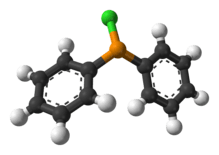Chlorodiphenylphosphine
Chlorodiphenylphosphine is an organophosphorus compound with the formula (C6H5)2PCl, abbreviated Ph2PCl. It is a colourless oily liquid with a pungent odor that is often described as being garlic-like and detectable even in the ppb range. It is useful reagent for introducing the Ph2P group into molecules, which includes many ligands.[1] Like other halophosphines, Ph2PCl is reactive with many nucleophiles such as water and easily oxidized even by air.
 | |
 | |
| Names | |
|---|---|
| Preferred IUPAC name
Diphenylphosphinous chloride | |
| Other names
chlorodiphenylphosphine p-chlorodiphenylphosphine diphenyl phosphine chloride diphenylchlorophosphine | |
| Identifiers | |
3D model (JSmol) |
|
| ChemSpider | |
| ECHA InfoCard | 100.012.813 |
| EC Number |
|
PubChem CID |
|
| UNII | |
CompTox Dashboard (EPA) |
|
| |
| |
| Properties | |
| C12H10ClP | |
| Molar mass | 220.63776 g mol−1 |
| Appearance | clear to light yellow liquid |
| Density | 1.229 g cm−3 |
| Boiling point | 320 ˚C |
| Reacts | |
| Solubility | Reacts with alcohols highly soluble in benzene, THF, and ethers |
| Hazards | |
| GHS pictograms |   |
| GHS Signal word | Danger |
GHS hazard statements |
H290, H302, H314, H318, H412 |
| P234, P260, P264, P270, P273, P280, P301+312, P301+330+331, P303+361+353, P304+340, P305+351+338, P310, P321, P330, P363, P390, P404, P405, P501 | |
Except where otherwise noted, data are given for materials in their standard state (at 25 °C [77 °F], 100 kPa). | |
| Infobox references | |
Synthesis and reactions
Chlorodiphenylphosphine is produced on a commercial scale from benzene and phosphorus trichloride (PCl3). Benzene reacts with phosphorus trichloride at extreme temperatures around 600 °C to give dichlorophenylphosphine (PhPCl2) and HCl. Redistribution of PhPCl2 in the gas phase at high temperatures results in chlorodiphenylphosphine.[1][2]
- 2 PhPCl2 → Ph2PCl + PCl3
Alternatively such compounds are prepared by redistribution reactions starting with triphenylphosphine and phosphorus trichloride.
- PCl3 + 2 PPh3 → 2 Ph2PCl
Chlorodiphenylphosphine hydrolyzes to give diphenylphosphine oxide. Reduction with sodium affords tetraphenyldiphosphine:
- 2 Ph2PCl + 2 Na → [Ph2P]2 + 2 NaCl
Uses
Chlorodiphenylphosphine, along with other chlorophosphines, is used in the synthesis of various phosphines. A typical route uses Grignard reagents:[2]
- Ph2PCl + MgRX → Ph2PR + MgClX
The phosphines produced from reactions with Ph2PCl are further developed and used as pesticides (such as EPN), stabilizers for plastics (Sandostab P-EPQ), various halogen compound catalysts, flame retardants (cyclic phosphinocarboxylic anhydride), as well as UV-hardening paint systems (used in dental materials) making Ph2PCl an important intermediate in the industrial world.[1][2]
Precursor to diphenylphosphido derivatives
Chlorodiphenylphosphine is used in the synthesis of sodium diphenylphosphide via its reaction with sodium metal in refluxing dioxane.[3]
- Ph2PCl + 2 Na → Ph2PNa + NaCl
Diphenylphosphine can be synthesized in the reaction of Ph2PCl and LiAlH4, the latter usually used in excess.[4]
- 4 Ph2PCl + LiAlH4 → 4 Ph2PH + LiCl + AlCl3
Both Ph2PNa and Ph2PH are also used in the synthesis of organophosphine ligands.
Characterization
The quality of chlorodiphenylphosphine is often checked by 31P NMR spectroscopy.[5]
| Compound | 31P chemical shift
(ppm vs 85% H3PO4) |
|---|---|
| PPh3 | -6 |
| PPh2Cl | 81.5 |
| PPhCl2 | 165 |
| PCl3 | 218 |
References
- Quin, L. D. A Guide to Organophosphorus Chemistry; Wiley IEEE: New York, 2000; pp 44-69. ISBN 0-471-31824-8
- Svara, J.; Weferling, N.; Hofmann, T. "Phosphorus Compounds, Organic," In 'Ullmann's Encyclopedia of Industrial Chemistry, 7th ed.; Wiley-VCH: 2008; doi:10.1002/14356007.a19_545.pub2; Accessed: February 18, 2008.
- Roy, Jackson W; Thomson, RJ; MacKay.m.f, . (1985). "The Stereochemistry of Organometallic Compounds. XXV. The Stereochemistry of Displacements of Secondary Methanesulfonate and p-Toluene-sulfonate esters by Diphenylphosphide Ions. X-ray Crystal Structure of (5α-Cholestan-3α-yl)diphenylphosphine Oxide". Australian Journal of Chemistry. 38 (1): 111–18. doi:10.1071/CH9850111.CS1 maint: numeric names: authors list (link)
- Stepanova, Valeria A.; Dunina, Valery V.; Smoliakova, Irina P. (2009). "Reactions of Cyclopalladated Complexes with Lithium Diphenylphosphide". Organometallics. 28 (22): 6546–6558. doi:10.1021/om9005615.
- O. Kühl "Phosphorus-31 NMR Spectroscopy" Springer, Berlin, 2008. ISBN 978-3-540-79118-8